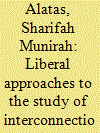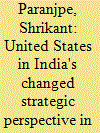|
|
|
Sort Order |
|
|
|
Items / Page
|
|
|
|
|
|
|
| Srl | Item |
| 1 |
ID:
117894


|
|
|
|
|
| Publication |
2013.
|
| Summary/Abstract |
Security issues in international relations, particularly during the era of the Cold War, were and had been dominated by the realist paradigm which saw the preservation of the state from external threat. Such a conception of security provided a very myopic and narrow understanding of the security problem of states, particularly smaller states. During the past decade, attempts are being made to broaden the security agenda to include not only military but also other sectors: political, economic, societal and ecological. Furthermore, with globalisation and the opening up of the economy has provided scope for cross-border migration and also illicit trade, especially narcotics, terrorism and a dangerous mix of both: narco-terrorism. This article will throw a light on the non-traditional security threats problem and issues of illicit drug trafficking and narco-terrorism in North-east India particularly in the case of Manipur.
|
|
|
|
|
|
|
|
|
|
|
|
|
|
|
|
| 2 |
ID:
117891


|
|
|
|
|
| Publication |
2013.
|
| Summary/Abstract |
Central Asia is becoming an increasingly attractive destination for foreign direct investment (FDI). Although a first wave of foreign investments targeted Central and Eastern Europe in the early 1990s, followed by a second one to South-east Europe in the early 2000s, FDI is now moving even further eastward towards Central Asia. The Central Asian countries are all relatively small landlocked economies and need to promote trade and investment which enable them to closely integrate into the international economic order to achieve sustainable economic development. The level of intra-regional trade in Central Asia is low and their trade is concentrated in few commodities and hence the possibilities of setting up joint ventures emerges so that instead of exporting and importing the same product, one country may decide to set up a joint venture in the partner country (with a more favourable investment climate and cost advantage) to buy back the same in the home country. The track record of FDI in Central Asia demonstrates the urgent need to strengthen good governance, transparency, stability and the fair application of the rule of law in the region. Therefore, this article seeks to examine the prospects and challenges of regional investment cooperation and provide some of the measures to enhance the effectiveness of bilateral investment treaties and double tax avoidance treaties among the Central Asian countries.
|
|
|
|
|
|
|
|
|
|
|
|
|
|
|
|
| 3 |
ID:
117893


|
|
|
|
|
| Publication |
2013.
|
| Summary/Abstract |
Since 2004, with the new premierships of Manmohan Singh, in India, and Abdullah Badawi, in Malaysia, India and Malaysia have been playing active roles in decision-making on many issues, regionally through regional blocks. Despite these positive developments, the area where there is a pressing need for the two countries to discuss and act upon concerns environmental security, mainly freshwater scarcity and security. Both India and Malaysia face worrying proportions of freshwater shortages, due to a number of reasons, including increasing individual consumption, industrialisation and poor agricultural practices. This article discusses how both India and Malaysia, as well as their roles in four regional organisations, can recognise the problem of freshwater scarcity and security and propose solutions for adaptation and mitigation. The theoretical framework within which this discussion is couched in is liberalism.
|
|
|
|
|
|
|
|
|
|
|
|
|
|
|
|
| 4 |
ID:
117892


|
|
|
|
|
| Publication |
2013.
|
| Summary/Abstract |
This article investigates how a Pakistan-terrorism nexus originated and then became solidified and embedded into Indian security perspectives. From the First Kashmir War in 1947-1948 to the 26 November 2008 Mumbai attacks, it has been the repeated behaviour of Pakistan towards India, and the nature of their major national and sub-national conflicts, which has led to this nexus. Central to its formation has been the repeated military strategy of initial infiltrations by irregular troops followed by the use of conventional troops-an approach employed by Pakistan in 1947, 1965 and 1999. Pakistan's concurrent support of various insurgencies and terrorism against India has compounded this association, and entrenched the contemporary Pakistan-terrorism nexus within India's (foreign and domestic) security perspectives. Given its persistent resonance within both Pakistani strategic behaviour and Indian elite mindsets, the article finds that the Pakistan-terrorism nexus will remain as a durable and critical lynchpin within South Asian security dynamics.
|
|
|
|
|
|
|
|
|
|
|
|
|
|
|
|
| 5 |
ID:
117890


|
|
|
|
|
| Publication |
2013.
|
| Summary/Abstract |
Indian strategic thinking is a product of its historical, cultural, geopolitical, socio-economic compulsions; it sought a preservation of India's strategic autonomy with a revisionist perspective that was structured to tackle the status quo created by the great powers. Today, given India's technological and economic capabilities, it is demanding space in the decision-making circles of the world. India-US security dialogue began sometime in the late 1980s. It was only after September 2001 that India-US security ties gained real momentum. The new key word in India-US defence relationship is 'inter-operability'. It signifies the mutual desire of both the countries to work more closely in the area of military cooperation and also portrays a possibility of sharing strategic doctrines and operations in the future to tackle new challenges. There are several issues that are likely to dominate the security dialogue. They include issues of terrorism associated with Pakistan and Afghanistan and American policies in that area; the question of technology transfer; nuclear non-proliferation; and the overall political discourse on non-military aspects like Human Rights and the ethnic nationalism based right to political self-determination movements that appear to elicit American attention at times.
|
|
|
|
|
|
|
|
|
|
|
|
|
|
|
|
|
|
|
|
|